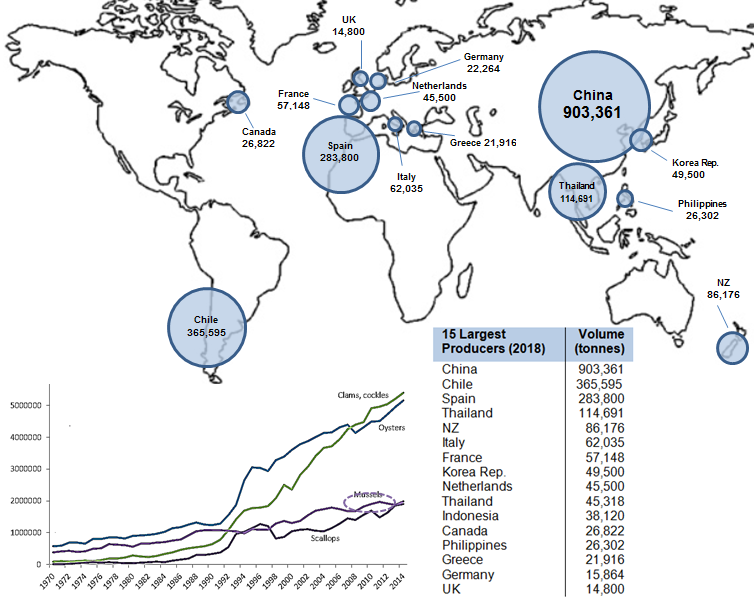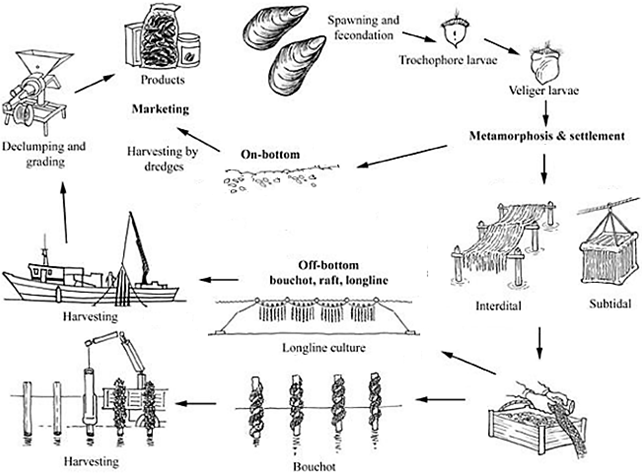Mussels
Various species
Sources, Quantities and Cultivation Methods
Sources and Quantities
Mussel farming extends across many countries in temperate and tropical regions and includes nine main species1, as shown in the table below. There are three species in what is known as the blue mussel complex (Mytilus edulis, Mytilus galloprovincialis and Mytilus trossulus) and they show varying levels of hybridisation wherever they occur within overlapping geographical areas. The UK for example farms M. edulis, M. galloprovincialis and their naturally occurring hybrids2.

Mussels are bivalve molluscs, meaning that they have a two-part hinged shell. They feed by filtering mainly microscopic algae (phytoplankton), but also some organic detritus in sea water. Farmed mussel aquaculture operations are located in intertidal and shallow sub-tidal environments, as well as in deeper, offshore waters (20m or deeper)3. The two-hinged shells are generally thicker in mussels grown inter-tidally as they protect the mussel from the more dynamic nature of this environment (the wave and tidal action), and mussels grown inter-tidally may exhibit a longer shelf-life than those which are grown sub-tidally and suspended in the water column.
Mussels are farmed across the globe, and were worth US$4.5 billion from a 2018 production total of some 2.1 million tonnes1. China produced almost half of this volume. Other important producing countries are Chile and Spain, which between them produced almost 650,000 tonnes in 2018.

Some 10% of world mussel production enters international trade. Less than 5% of total world bivalve production enters international markets; one of the lowest proportions in seafood trade. This is due to the fact that the majority of bivalves are eaten in the countries where they are grown, and because they are a highly perishable product. The EU is one of the main markets for bivalves taking over one third of the total bivalve trade4.
China produces over 80% of the world's bivalves, but domestically consumes almost all of this production. Around 200,000 tonnes of mussels are internationally traded per year, with Spain and the US generally the main markets4.
European production of mussels is divided between bottom culture and rope grown; northern countries, especially the Netherlands, concentrate on the former, whilst Spain and Italy the latter1, 4. Spain and the Netherlands are the main exporters of European mussels, but Europe also imports significant quantities of farmed Chilean mussels5.
Mussels are available all year round, and technologies such as vacuum packaging make them even more accessible to the consumer. Large mussels are packed in bags of 5 or 10 kg, while smaller bags of 1 kg are produced for distribution to retail.
Mussels are processed and sold in various ways; whole, cleaned, cooked (with or without the shell i.e. pure mussel meat), and sometimes presented in their half shell.
Domestic Market Information6, 7
Our domestic seafood market is complex mix of products from wild caught and farmed species, including mussels, which in recent years, have grown in popularity in Great British retail (i.e. in England, Scotland and Wales).
To discover more about the highly dynamic and ever-changing UK and Great British (GB) seafood marketplace, you can explore our user friendly and interactive Trade and Tariff in Tableau (T4) online tool. And visiting our dedicated Insight and Research pages will provide you with access to a wealth of information, from reports to factsheets on markets including:
- Retail – data from independent and multiple retailers in the UK used to reveal the latest insights on seafood eaten at home
- Foodservice – data from the foodservice industry in the UK used to highlight the latest trends on seafood eaten out of home
- Market supply – HM Revenue and Customs (HMRC) data used to detail what species and products are imported from, and exported to, the UK
To get the latest seafood market performance and trends delivered to your inbox, register at the Market Insight Portal.
Production Method
Mussel farming is undertaken using a variety of methods based on the prevailing hydrographic, social, and economic conditions. The two main types of culture are either carried out on the seabed or by suspended culture3, 6. On-growing of mussels is sea-based, and the type of rearing method depends on both the environment (tidal range, water depth, and so on) and tradition. No feed is supplied and no chemicals or medicines are administered.
Seabed culture involves locating and dredging seed mussel of around 10mm shell length from offshore beds and relaying them in more productive, protected locations; in the UK such areas are often termed a ‘lay’7. Across the UK, in Wales, N Ireland, The Wash, North Norfolk and Poole Harbour in England, mussel production is mostly derived from bottom culture and within restricted Several or Regulating Order fisheries (i.e. where a person or company is granted legal ownership of the mussels in a given area of seabed to enable their cultivation)8, 9. In 2016, 6,136 tonnes of UK mussels where produced “on bottom”10.

In suspended or “off bottom” culture mussels are farmed on systems of rafts, ropes and floats, where they grow until harvest 18-24 months later. The UK produced 8,549 tonnes of off-bottom mussels in 201610, and these came predominantly from Shetland and elsewhere in Scotland. Suspended mussel production is increasing in Wales and England.
Mussel juveniles or ‘spat’ used for farming are either collected from the wild or settle naturally on purpose-made collectors. However, predicting the occurrence, time, location and size of any spat-fall is difficult, and there are many environmental variables to be taken into account. This introduces uncertainty and unreliability in seed supply to growers and often results in fluctuations in the supply of mussels to processors, retailers and eventually consumers. Hatchery production of spat is possible and may be a method by which a reliable mussel spat supply can be supplied to farmers11. The establishment of a mussel hatchery is currently going on in Shetland in order to address the issues of reliability and quality of Scottish spat12.